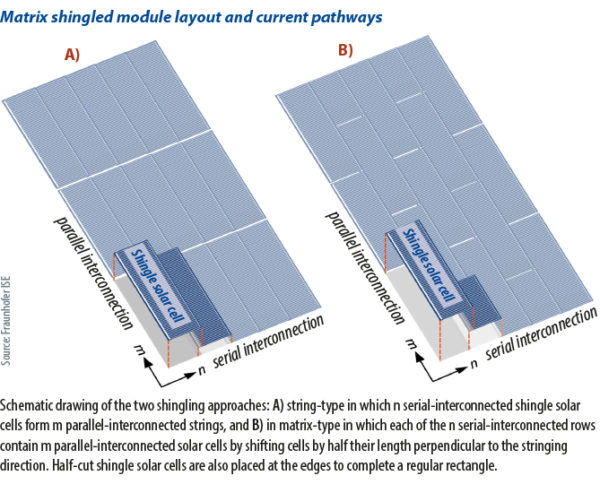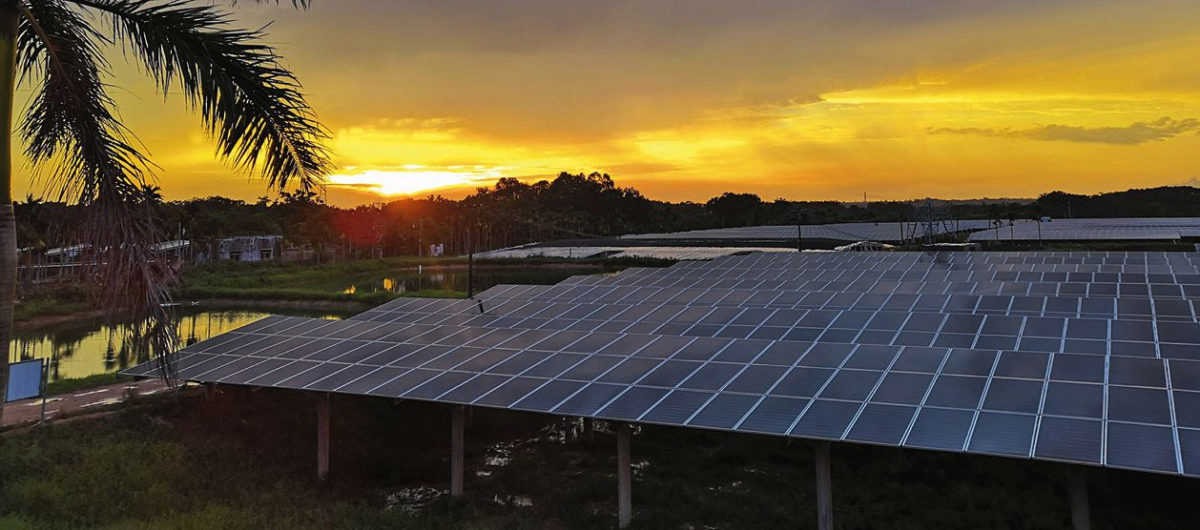New 400 W-plus shingled solar modules are on the market, serving demand for high-powered, more durable, sleek all-black products. Chinese cell giant Tongwei is responsible for the new modules – its Terra series released in 2022. The Terra series comes in power classes of 400 W to 430 W, with efficiencies ranging from 20.1% to 21.7%.
Tongwei is notable as a major Chinese supplier embracing shingling, which involves cutting solar cells into strips which are then interconnected through electrically conductive adhesive (ECA), slightly overlapping along the long cell edge.
The head of Tongwei’s shingled module department, Yan Li, says shingled products offer “advantages in power, efficiency, and reliability” and technical advantages because of “high-density packaging and flexible interconnection.”
“However, we believe that the differentiated Terra high-efficiency shingled modules with aesthetic appearance will target some markets, and increase our share and brand influence in the residential segment,” says Li. Alongside sleek aesthetics and power, shingling also delivers durability, Li claims, due to its “low hot-spot risk, resistance to micro-cracks and exceptional mechanical load performance.”
Tongwei, which has 70 GW of annual cell capacity – and plans to hit 130 GW to 150 GW by 2026 – reports having 6 GW of Terra lines, while module capacity has reached 14 GW, including half-cut series'.
IP claims
While Tongwei’s adoption of shingling represents a major development of the technology at scale, the commercialization of shingling has been years in the making. Silicon Valley-based Solaria Corporation, founded in 2000, began selling shingled PowerXT modules in 2016. Solaria claims to hold “over 250 issued and pending patents in the field,” many of which, presumably, relate to shingling.
The Californian company has robustly defended what it considers its intellectual property (IP). In June 2022, it settled a patent infringement lawsuit filed in 2020 against Sino-Canadian manufacturer Canadian Solar for allegedly infringing its shingling technology.
Solaria wants to merge with installer Complete Solar and float the resulting Complete Solaria business as a vertically-integrated company similar to SunPower. Complete Solaria would make shingled PowerXT modules with an output of around 400 W under a “low capex [capital expenditure] model,” with production “by manufacturers in Thailand, Cambodia, Vietnam, and India.”
Robust IP
Tongwei says it began module R&D in 2016 and attached importance to the establishment of an intellectual property system. “From the beginning of the shingled product project, Tongwei has already started the layout in the patent end,” says Li. “After seven years, Tongwei has formed an independent shingled technology roadmap.”
George Touloupas, senior director of technology and quality at quality assurance provider Clean Energy Associates (CEA), points to Tongwei’s statements the company has its “own way of interconnecting,” free of IP concerns. Touloupas adds, “The shingled module chief technology officer is formerly from SunEdison and he is bringing his shingling experience from that company to Tongwei.”
Peering under the hood, Touloupas observes that the interconnection approach used by Tongwei appears to have additional benefits. “Tongwei is also exploring a different interconnection technology where shingled cells follow a jagged pattern, which is even more resilient to hot-spots and has lower loss due to shading.”
Popular content

Matrix layout
Researchers at Germany’s Fraunhofer ISE published test results from such a shingled-module cell layout in the journal Progress in Photovoltaics in 2021. In the paper, the researchers term the technique a “matrix layout” whereby the cut cell pieces are placed in an offset pattern, “by half a cell length” – with half-cut shingle cells placed at the edges to result in a standard rectangular module format.
“By shifting the solar cells from row to row by half a cell length, an additional parallel interconnection of all solar cells within each row is achieved,” the researchers wrote.
The Fraunhofer ISE team tested matrix shingled modules in various shading scenarios, including with shading diagonally across the module, and found that the matrix design resulted in significantly increased energy yield. Electric current could bypass shaded areas more effectively due to the offset cell layout. The layout also reduced the risk that mechanisms causing hotspots – a result of partial shading – would occur.
As ideal, unshaded locations for solar become increasingly scarce, the Fraunhofer researchers concluded that the matrix layout would become increasingly valuable. “Huge potential for solar power generation meets a huge variety of irregular shading conditions, making shading tolerance a very important aspect,” wrote the academics.
Challenges remain
Advances in shingling technology, and its adoption in manufacturing at a larger scale, point to the technology potentially moving into a new era of development. Competition from other technologies will remain fierce, however.
“Four or five years ago, shingled modules had about [a] 10% efficiency advantage compared to ordinary – at the time – full-cell, four-busbar modules; that’s not the case any more,” says CEA’s Touloupas. “With the introduction of half-cut cells, multi-busbar, paving, or tiling; this 10% module area efficiency advantage has evaporated.”
As Tongwei and other shingling proponents argue, there are a host of advantages beyond efficiency. The use of ECA rather than busbars, which contain lead, is one such advantage – adding environmental credentials to the shingled approach, alongside durability, shading tolerance, and aesthetics. As with some other high efficiency technologies, the silver content in ECA will have to continue to come down for its use to be sustainable in larger volumes (see box).
Low-silver ECA
ECA has relatively high silver content – as much as 70% to 80% has been noted by academics in commercial products as recently as 2019. That could change, however, thanks to silver-coated conductive particles and optimized particle shapes. “We probably started with reducing the silver consumption of our adhesives, maybe 10 years ago,” says Rich Wells, chief technology officer of Ohio-based, Japanese-owned Nagase Chemtex America, a manufacturer with more than 15 years' experience supplying solar companies. “Recently, I would say in the last five years, there have been some very nice breakthroughs.” Wells says progress in reducing the silver content of ECA destined for solar has come via two key developments. The first is the replacement of pure silver particles with silver-coated alternatives. Copper at the core of the particles, says Wells, “is one of the many options out there.” Nagase Chemtex worked with researchers from the Energy Research Centre of the Netherlands to develop silver coated particles for ECA. The Ohio business’ scientists are also trying to optimize particle shapes. Longer, flatter particles deliver equivalent conductivity from a smaller volume of conductive metal. “The models for percolation, to build a conductive network through the system, indicate that you can create that network of conductivity at a lower [metal] loading if you have a higher aspect ratio,” says Wells. Mark Francis, Nagase Chemtex’s sales and marketing manager, has a long history in the semiconductor industry. He says, upon joining the company primarily to develop its solar business, he was surprised to learn PV manufacturers were using lead solder for cell interconnection. “We are seeing the push for silver reduction of both the cell grid and the interconnection,” says Francis. “What I’m wondering is, when will they turn around and say we don’t want to do cell interconnection with lead any more?”

Tongwei reports that it is working to optimize both the bonding strength of the ECA and its conductivity – which it terms the non-silver and silver system, respectively. “We are committed to bringing our efficient and eco-friendly Tongwei Terra series to more households,” the company states.
This content is protected by copyright and may not be reused. If you want to cooperate with us and would like to reuse some of our content, please contact: editors@pv-magazine.com.



“as a vertically-integrated company similar to SunPower”
As Sunpower before the Maxeon spin out no?
Hi Ploulack, thanks for your comment. You’re right, “prior to the Maxeon spin off” would have been more precise. It was the model that most closely resembled the one being pursued by Solaria and hence why I used it. Well spotted!